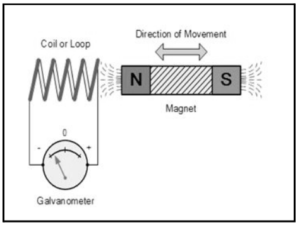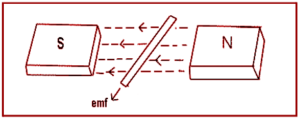Table of Contents
Introduction:
Magnetism is the force produced by magnets when they attract or oppose each other. Magnetism conveys a mysterious quality. Its capability to change metals like iron, cobalt, and nickel when touched fascinates children. By observing the form of the magnetic field created by the iron filling surrounding the bar magnet, we can learn about the repulsion and attraction between the magnetic poles.
The forces that govern both magnetism and electricity, according to physicists, are significantly larger than gravity in electromagnetism. The maglev train, which is suspended above its tracks, is a magnificent display of enormous force. Induction is a procedure in which a conductor is positioned in a specified position and the magnetic field varies or remains stationary while the conductor travels.
As an outcome, a voltage or EMF (Electromotive Force) is established across the electrical conductor. The Law of Induction was discovered by Michael Faraday in 1830.
The information about electromagnetic induction and Faraday’s Law from various physics-related articles are available here. Faraday’s Law and its general concepts are important topics in physics. Students who want to flourish in physics need to be well known about electromagnetic induction and Faraday’s Law to get deep knowledge about it to do well on their exams. The definition, laws, and formula are provided here to assist students in effectively understanding the respective topic. Continue to visit our website for additional physics help.
Overview:
In general, ‘Electromagnetic Induction’ is the induction of an electromotive force by the motion of a conductor across a magnetic field or by a change in magnetic flux in a magnetic field. It is a non-contact mechanism in which a changing magnetic flux (i.e., changing number of magnetic field lines) is caused by a second circuit placed in the magnetic field.
Current flows in the second circuit as a result of this change. The most prevalent method of generating electricity is electromagnetic induction, which is based on the rotation of a magnet around a stationary conductor. A magnetic induction current is the induced electric current that occurs when an alternating electric field is applied to a conductor carrying an electric current.

When a conductor is set in a moving magnetic field (using an AC power source), or when a conductor is always moving in a stationary magnetic field, this occurs.
Michael Faraday discovered this electromagnetic induction law. He set up a leading wire, which he connected to a device that measured the voltage across the circuit. When a bar magnet passes through the device, the voltage in the circuit is monitored.
The significance of this is that it is a method of producing electrical energy in a circuit by employing magnetic fields rather than batteries.
Faraday’s law of electromagnetic induction, sometimes known as Faraday’s law, is a fundamental law of electromagnetism that explains how a magnetic field interacts with an electric circuit to generate an electromotive force (EMF).
There are two laws that makeup Faraday’s Laws of Electromagnetic Induction. The first law defines the emf induction in a conductor, while the second law quantifies the emf produced.

According to the Lenz law of electromagnetic induction, when an emf is induced as per Faraday’s law, the polarity (direction) of that induced emf resists the source of its formation.
Faraday’s First Law of Electromagnetic Induction:
Faraday and Henry conducted a long series of experiments that led to the discovery and understanding of electromagnetic induction. Faraday deduced from his experiments that when the magnetic flux across the coil changes with time, an emf is induced in the coil.
An electromotive force is induced whenever a conductor is put in a changing magnetic field, according to Faraday’s first law. A current is induced when the conductor circuit is closed, and this is known as induced current.
Ways of Changing the Magnetic Field:
In a circuit, there are four ways to alter the magnetic field.
- The coil rotates with respect to the magnet.
- The coil is moved into the magnetic field or out of the magnetic field.
- By changing the area of a coil that is kept in a magnetic field.
- By moving a magnet in the coil’s direction or away from the coil’s direction.
Faraday’s Second Law of Electromagnetic Induction:
According to the law, the induced emf in a conductor is equal to the rate at which the flux associated with the circuit changes. This flux is equal to the product of the wire flux and the number of turns in the wire.
Faraday’s law of electromagnetic induction, which states that the amount of voltage induced in a coil is proportionate to the number of turns and the changing magnetic field of the coil, was developed based on his observations.
The flux is equal to the product of the coil’s number of turns and the flux associated with it. Faraday’s law is expressed as:
ε =-NΔΦ/Δt
Here is considered as the electromotive force, which is called the magnetic flux, and N is said to be the number of turns.
Derivation of Faraday’s Law :
We have a magnet approaching a coil.
Let us consider two-time instances T 1 and T 2.
Now, the flux linkage with the coil at the time T 1 will be,
T 1=NΦ1
And the flux linkage with the coil at the time T 2 will be,
T 2=NΦ2
Then, the change in the flux linkage will be,
N(Φ1-Φ2 )
This change in flux linkage can be considered as,
Φ=Φ1-Φ2
Thus, the net change in flux linkage will be,
NΦ
Then, the rate of change of flux linkage will be,
NΦ/t
Now, differentiate the above equation,
NdΦ/dt
It is known that the induced emf in a coil will be equal to the rate of change of flux linkage according to Faraday’s second law.
Thus,
E=Ndϕ/dt
Now, by Lenz’s law,
E=-Ndϕ/dt
Also read: Important Topic of Physics: Ammeter
Frequently Asked Question (FAQs):
Question 1: What are Faraday’s Law – Formula and Example related to?
Answer: The mechanism of Electromagnetic Induction is described by Faraday’s Law – Formula and Example. Faraday came up with these rules and formulas after conducting a series of experiments. He came to the conclusion that when the magnetic flux across a closed-looped coil varies over time, an emf is generated. It also gives the induced emf’s value and direction, which is determined by Lenz’s law.
Question 2: What is meant by Electromagnetic Induction?
Answer:In general, ‘Electromagnetic Induction’ is the induction of an electromotive force by the motion of a conductor across a magnetic field or by a change in magnetic flux in a magnetic field. It is a non-contact mechanism in which a changing magnetic flux (i.e., changing number of magnetic field lines) is caused by a second circuit placed in the magnetic field.
Question 3: Explain how many laws does Faraday’s Law have?
Answer:Electromagnetic Induction is covered by two laws in Faraday’s Law. The phenomenon of an electromotive force (emf) being induced in a conductor placed in a fluctuating magnetic field is the basis for Faraday’s first law. The induced emf is equal to the rate of change of magnetic flux, according to Faraday’s second law. The formula for induced emf in terms of magnetic flux and coil turns is also found in the second law. Lenz’s law, which deals with the polarity of the induced emf, provides a negative sign explanation for the formula.





